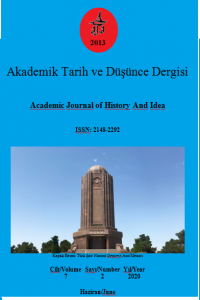Merzifon Cami ve Mescit Mihraplarında Tezyinat Unsurları
Amasya Orta Karadeniz’in en eski yerleşim merkezlerinden biri olmakla beraber, Osmanlıların da önemli şehzade sancakları arasında yer almaktadır. Birçok medeniyetin izlerini taşıyan Amasya çok sayıda esere sahiptir. Bu eserler Amasya merkez, ilçe, köy ve kasabalarında kendilerini göstermekte, bunların başında çoğunu cami ve mescitlerin oluşturduğu farklı mimari yapı tiplerine ev sahipliği yapan Merzifon gelmektedir. Merzifon cami ve mescitlerinin bazıları mimarî veya süsleme sanatlarıyla ilgili genel çalışmalara, bazıları da münferit yayınlara konu edilmiştir. Ancak Merzifon cami ve mescitlerindeki mihrap süslemeleri üzerine ayrıntılı herhangi bir çalışma yapılmamıştır. Mihrapların detaylı şekilde ortaya konması sanat tarihi açısından önem arz etmektedir. Bu çalışmada Merzifon cami ve mescit mihraplarında uygulanan tezyinat unsurları konu edilmiştir. Merzifon’da araştırma sonucu toplam 28 mihrap tespit edilmiş; ancak mihrapların çoğu bazı sebeplerden dolayı özgün hallerini kaybetmişlerdir. 28 adet mihraptan 12’si sade bir yapıya sahip olduğundan bu çalışmada, üzerinde tezyinat unsuru barındıran 16 mihrap değerlendirmeye alınmıştır. 16 mihraptan 15’i camilerde 1’i mescitte bulunmaktadır. İncelenen mihrapların tezyinat unsurları; bitkisel, geometrik, Kuran yazıları, mukarnas bezemeleri, kalemişi ve diğer motifli süslemeler olmak üzere beş grupta değerlendirilmiştir.
Anahtar Kelimeler:
Sanat tarihi, Merzifon, Cami, Mihrap, Tezyinat
Ornamentation Elements of Mihrabs in Mosques and Masjids of Merzifon
Along with being one of the oldest settlements in the Middle Black Sea region, Amasya is also among the significant princely sanjaks of the Ottomans. Carrying the traces of many civilizations, Amasya has many artifacts. These artifacts show themselves in the center, districts, village sand towns of Amasya, and the foremost of them are Merzifon, which hosts different architectural building types, most of which are mosques and masjids. Some of the Merzifon mosques and masjids are the subject of general studies on architecture or decorative arts, and some of them are the subject of stand-alone publications. However, no detailed study has been carried out on the mihrab decorations in Merzifon mosques and masjids. It is important in terms of Art History to reveal mihrabs in detail. This study discusses the elements of decoration applied in Merzifon mosque and masjid mihrabs. As a result of the research, a total of 28 mihrabs were identified in Merzifon; however, most of the mihrabs lost their originality for some reason. Since 12 of the 28 mihrabs have a simple structure, 16 mihrabs with ornamental elements were evaluated in this study. 15 of the 16 mihrabs are in mosques and one mihrab is in the masjid. Ornamental elements of the examined mihrabs were evaluated in five groups as herbal, geometric, Qur'an icinscriptions, muqarnas decorations, hand-drawn and other motifs.
Keywords:
Art History, Merzifon, mosque, mihrab, ornament.,
___
- BAKIRER, Ö., XIII. ve XIV. Yüzyıllarda Anadolu Mihrapları, Türk Tarih Kurumu Basımevi, Ankara 2000.
- ERZİNCAN, T., “Mihrap”, Türk Diyanet Vakfı İslam Ansiklopedisi, C. 30, TDV Yayınları, İstanbul 2005, s. 30-37.
- Yayın Aralığı: Yılda 6 Sayı
- Başlangıç: 2013
- Yayıncı: Hakan YILMAZ
Sayıdaki Diğer Makaleler
Nahçıvan Özerk Cumhuriyetinde Tarımın Durumu (1991-2016 yılları)
XVI. Yüzyılda Bana Kazasında Vergi Muâfiyeti Uygulaması
Bəxtiyar Vahabzadənin şeirlərində milli-mənəvi yaddaş
Merzifon Cami ve Mescit Mihraplarında Tezyinat Unsurları
Orhun Yazıtlarında Halk Bilimi Unsurları
Uygur Harfli Oğuznamedeki Hayvanlarla Oğuz Kağan’ın İlişkisi
‘Talât Paşa Evrakı’nın Muhtemel Kaynaklarından Birisi
Avrasya Ekonomik Birliği Çerçevesinde İşçi Göçlerin Düzenlenmesi
Antik Yunan ve Roma Dünyasında Fizyonomi: Tarihsel Köken, Bakış Açısı ve Yöntem
